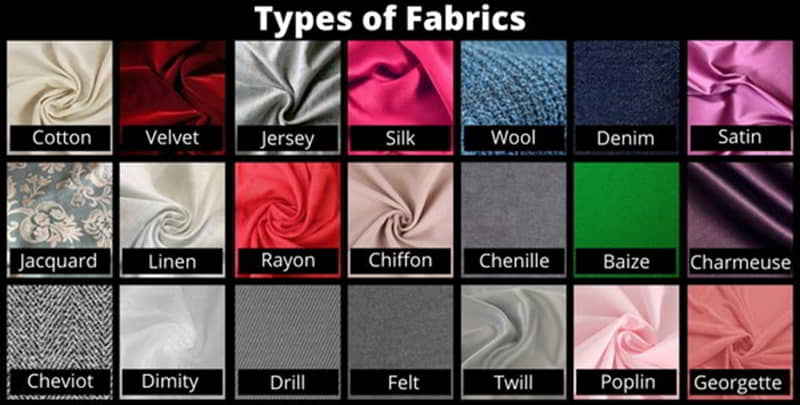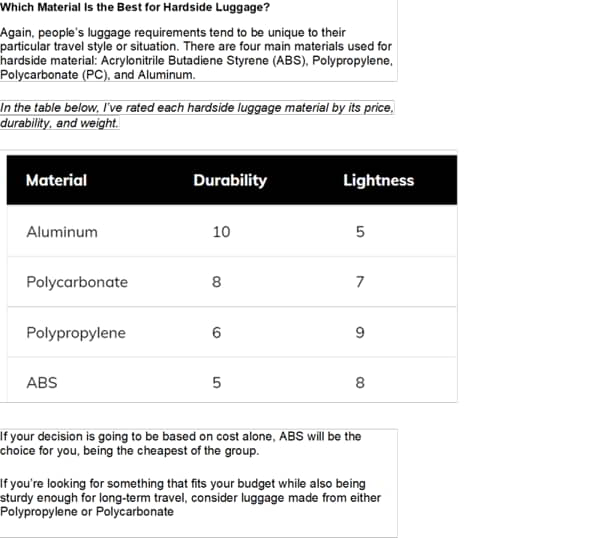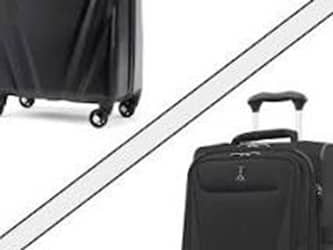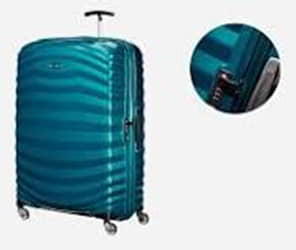Things to Consider when Buying Luggage Cases made with Different Textile Fabrics
Soft fabrics used for luggage carriers like Nylon and Polyester fabrics made with different Deniers and GSM
Different kinds of narrow fabrics such as ribbons, laces, cords, tapes, labels, webbings, wicks, elastics, ropes, straps, trims, fringes, lanyards, etc. may be crafted out of different kinds of materials such as leather, cotton, polyester, Teflon, rubber, jute, nylon, fiberglass, and beads for Luggage manufacturing.
Fabric Materials used for luggage carriers
Different kinds of narrow fabrics such as ribbons, laces, cords, tapes, labels, webbings, wicks, elastics, ropes, straps, trims, fringes and lanyards, etc. may be crafted out of different kinds of materials such as leather, cotton, polyester, Teflon, rubber, jute, nylon, fiberglass and also beads. Narrow fabrics are usually decorative in nature but are often used in a large variety of homes to add a decorative look to dresses and can also be attached to curtains; bed covers, etc., and industrial applications. Different kinds of materials used to make narrow fabrics are:
- Cotton tapes with fabric structure of plain, satin, velvet: The most practical and widely used medium, cotton is processed to make a highly decorative, luxurious medley of laces, wicks, tapes, webbings, and lots more.
- Polyester: The durable synthetic material is used to make different kinds of tapes, webbings, straps, etc.
- Teflon: Teflon is a popular material used for various kinds of tapes etc, for industrial applications.
- Rubber: Tapes made from rubber are widely used for different purposes.
- Jute: The 100% bio-degradable material is used for webbings.
- Nylon: Extremely durable & available in different colors & textures, nylon is made use of, for making high-quality tapes, straps, etc.
- Fiber Glass: Wicks made of fiberglass are gaining popularity due to their chemical properties
- Beads: Trims, fringes made of shiny beads of different shapes and sizes are gaining popularity
Applications



Fabrics are great for making backpacks, bags, cases, prams, sheets, pillows, sleeping bags, curtains, covers for clothing and furniture, home decoration, etc. Customization is available.
The mainlining fabric is a special high denier twisted fabric with Teflon coating, which is treated for repellency to fight off dry soil and nasty, unpredictable spills and splashes, allowing liquids to bead up and roll off. Liquid spills can easily be wiped away when blotted with a clean cloth, and dry soil can be brushed off easily. Further, the exterior is decorated with classic leather trims throughout, the design is also decorated with various high-quality metal embellishments to highlight the premium level.

The Best Hard Luggage Material

All hard luggage’s are durable and therefore offer the best protection of the items inside. The most popular hard material is polycarbonate, aluminum, ABS, and polypropylene. The aluminum suitcases are at the top of the range (durability, price), followed by polycarbonate, polypropylene, and ABS.
Aluminum suitcases have been around for a while and are a classic choice. However, they are expensive and therefore increasingly being replaced by other less expensive hard materials.

Polycarbonate is molded type of thermoplastic polymer and is a very popular material for hard luggage. It is lighter than aluminum but still very durable and offers more style choices, e.g., in colors and patterns. Another important benefit of polycarbonate as a luggage material is how impact-resistant it is. Upon impact, the material flexes to absorb the impact and then flexes back to its original shape, making polycarbonate luggage extremely resilient to rough handling.
Polypropylene, or polypropene, is also the type of thermoplastic polymer and the lightest of all the thermoplastic products, making it an ideal material for any lightweight luggage range.
Polypropylene is also very resilient (though not as much as polycarbonate). Polypropylene is a great choice for those travelers that want good protection in a lightweight form as possible.
ABS (acrylonitrile-butadiene-styrene) is a common thermoplastic. ABS is lighter than polycarbonate but not as durable. It is also the cheapest hard material, meaning it is popular in the cheaper hard-sided luggage ranges.
ABS is frequently added to other stronger luggage materials, e.g., polycarbonate. The combined material is more durable than ABS on its own but also lighter and cheaper than polycarbonate on its own.
Suitcases
What is the material of the suitcases?

There are loads of different blended luggage materials to choose from: aluminum, polycarbonate, ABS, polypropylene, nylon, ballistic nylon, Cordura nylon, polyester, canvas, oxford cloth, and leather. And some of them are going to withstand the pressure of a long-haul flight better than others.
What is the strongest material for a suitcase?
Polypropylene

Polypropylene is one of the strongest materials and is therefore also used in making Curv. The hard shell can withstand a strong impact. It is a good alternative for travelers who find the bags made of polycarbonate or Curv too expensive.
Which suitcase material is best for international travel?
Many travelers consider polycarbonate hard suitcases the best type of luggage because it’s lightweight. Delsey Helium Aero is a popular choice for polycarbonate luggage.
If your decision is going to be based on cost alone, ABS will be the choice for you, being the cheapest of the group.
If you’re looking for something that fits your budget while also being sturdy enough for long-term travel, consider luggage made from either Polypropylene or Polycarbonate
And finally, if the cost is not an issue and you’re looking for the most durable kind of suitcase, go for Aluminium.
In the table above we’ve compared the four materials used for hard side luggage, by price, durability, and weight. You’ll also find more information below specific to each material. Hopefully, this will help you judge what material is going to work best for you.
Acrylonitrile Butadiene Styrene (ABS)
Short for Acrylonitrile Butadiene Styrene, ABS is a mix of three different materials. Although it’s widely used in other industries as well, it’s the most popular material used for hard-side suitcases. Especially in affordable luggage, due to its cheap production costs.
When compared to other plastics used in hard-shell suitcases, ABS is the most rigid one. However, the rigidness doesn’t account for durability, because both polypropylene and polycarbonate are more durable and will last longer. Due to non-flexibility ABS suitcases are more likely to get cracks in the hard case.
Lastly, ABS is more lightweight than polycarbonate, but not as light as polypropylene. This is why cheaper hard-side suitcases are often more lightweight than the more expensive cases made from PC (Polycarbonate).
Polycarbonate (PC)
PC, short for Polycarbonate is the second most popular material used in hard-side suitcases.
PC is much more impact-resistant than ABS or Polypropylene. Upon first picking up ABS and Polycarbonate suitcases, you would think that ABS is more durable, because of its rigidness. But it’s actually not. Polycarbonate is much more flexible and offers more resistance to cracks, which is why it’s the perfect choice for applications where high durability is needed.
Polypropylene (PP)
Polypropylene is pretty rarely used in luggage when compared to ABS or Polycarbonate.
It’s the most lightweight material of the three, and it’s also pretty durable – It’s more durable than ABS but not as durable as polycarbonate. In terms of costs, it’s also not as expensive as a PC and priced somewhat similarly to ABS suitcases.
Unfortunately, one thing that is always noticed with polypropylene suitcases is that they feel cheap. Because of their weight and flexibility, this always perceived polypropylene suitcases as less durable than ABS or PC, which isn’t true. In actuality, the perceived durability might be the reason why polypropylene isn’t so popular in luggage.
Aluminum
Out of all hard-side suitcase materials, Aluminum is the most durable.
A clear icon of aluminum suitcases is Rimowa. They’ve been making aluminum suitcases since 1937, and their cases are almost indestructible. The durability lies in the material itself because aluminum is so tough to break. When put under high pressure, aluminum is likely to bend instead of cracking.
However, aluminum is pretty rarely used in suitcases. Mainly, because it’s heavier than plastics and costs much, much more. Usually, aluminum suitcases cost 500$-1200$, which is expensive when compared to say, durable polycarbonate suitcases, which can be bought for 100$-200$.
Soft side Luggage Materials Compared
| Material | Durability | Lightness | Price | |
|---|---|---|---|---|
| Polyester | 5 | 9 | $$ | |
| Oxford cloth | 6 | 8 | $$ | |
| Nylon | 7 | 8 | $$$ | |
| Cordura nylon | 8 | 6 | $$$$ | |
| Ballistic nylon | 9 | 6 | $$$$ | |
| Canvas | 8 | 5 | $$$$ | |
| Leather | 9 | 4 | $$$$ |
Soft luggage fabric by its price, durability, and weight.
Hard vs. Soft Luggage Cases
Both have their benefits. Hard side luggage offers more protection, it’s easier to clean and waterproof. On the other hand, fabric suitcases are more flexible, lightweight, and don’t crack. In durability and price, both are pretty similar.
Let’s take a look at all the benefits that each type offers.
Hardshell Luggage Benefits
- Can’t overpack. That’s good for carry-on luggage, where size restrictions play a significant role;
- Better protection for electronics and fragile items;
- Waterproof or water-repellant;
- It can be easily cleaned.
- Often comes with TSA-approved combination locks.
Hard side Luggage Disadvantages
- Cracks can start to appear after normal wear;
- Can’t be squeezed in tight overhead compartments;
- Often heavier;
- Split-book style openings aren’t too useful for packing cubes;
- Gets scratched. Consider using a luggage cover for minimizing scratches.
Fabric Luggage Benefits
- Often lighter than hard suitcases;
- It can be overpacked. That’s good for checked luggage if you’re still within the weight limit;
- Easier to fit in tight spaces;
- Looks new longer, because scratches aren’t visible;
- Good for packing cubes.
Disadvantages of Fabric Luggage
- Can get tears in the fabric;
- Harder to clean;
- Water easily penetrates through the material;
- Less protection for hard objects and fragile items;
- Rarely comes with luggage locks.
Should You Get Hardside or Softside Luggage?

The popularity of the two has definitely fluctuated over time. In the 60s and 70s, hard side luggage was more commonly used, however, changes in technology have led to changes over time, with softside luggage becoming more popular. Nowadays the world of luggage material has flipped again, and the hard side has made a comeback.
What you can take from this anecdote is that there will always be reasons to choose hand side over outside, and vice versa. As you can see both luggage types have their advantages and disadvantages. It’s up to you to figure out what your priorities are in choosing a suitcase. Choose your parameters, and deciding on what to buy will be much easier.
Things to Consider When Buying Softside Fabric Luggage
I’ve researched way too many fabric suitcases, so I know a thing or two. Here are the main things that are considered for looking for suitable fabric luggage.
- Invest in nylon luggage. Whether that’s ballistic nylon, Cordura, or regular nylon, it’s worth it to spend 30-100$ extra for a more durable material.
- Check the zippers. Spend a few minutes browsing the reviews and seeing if broken zippers are a thing between the customers. Often, the cheaper fabric cases are fitted with cheap zippers that break easily. Ideally, you want thick and durable zippers, like the YKK zippers.
- If there are no spinner wheels, make sure that the bottom part is made from thick fabric. In a lot of affordable fabric suitcases with skate wheels, the bottom portion will be the first to show tears and scuff marks.
- Consider getting your fabric suitcases in black. Brightly colored fabric luggage can get ugly pretty fast with oil stains and scuff marks.
- Check if the case is expandable. One of the benefits of soft side luggage is its ability to expand if you need to pack any extras. Make sure to check this feature is included as you never know when you’ll need it.
Things to Consider When Buying Hard Shell Luggage
More careful about buying hard-shell luggage, just because often the cheaper suitcases can break after one or two trips. If you’re getting a cheap suitcase, it’s better to buy a fabric one with skate wheels. For hard side cases, you should spend at least 100$ or more.
- Choose polycarbonate or aluminum. Most of the time, polycarbonate is the best option because it’s moderately priced and durable.
- Buy a case with a scratch-resistant finish. All the glossier models get scratched just after a few trips. Instead, get a patterned finish.
- Some manufacturers make incredibly heavy hard side suitcases, so be sure to check the weight before buying.
- Make sure the dimensions are correct. Ideally, you want hard side carry-ons to be below 22 x 14 x 9 inches with the wheels and handles included. Often, the dimensions listed are without wheels and handles, so make sure to get the correct dimensions.
- Read the reviews first. Often cheap hard-side suitcases get cracks, broken spinner wheels, broken handles, and broken zippers. Make sure to spend five minutes reading the reviews before buying.
- Get a case with expandable width and TSA-approved locks. For new hard-side suitcases, these features are a must-have.
By Ashok Hakoo; B. E (Textiles), M.B.A.
Technical/Management Textile consultant.
Acknowledgment: Technical and technological Facts in this write-up has been selected from various reliable sources.



High quality luggage and backpack supplier(Roy)
Hello!
Greetings! Glad to find that your work in the field of luggage and bags
This is Roy from China, a large supplier of Backpack,Luggage,
Suitcase and Bags.
We can manufacture backpack and luggage in various materials and
styles, PP/PCIABS/ABS+PC luggage and soft luggage.
We are mainly in OEM and ODM.
Currently we have some new designs products coming out
Would you mind we share some of our popular products with you?
We are looking for chances to cooperate with you.
And we are deeply involved in the field more than 20 years.
We can support good quality with very competitive price.
P.S. We will highly appreciated if you can advise purchaser’s contact info
or forward my mail to the person who takes in charge of purchasing.
Sincerely
Thanks
Mit freundlichen Grüßen/Kind regards
Roy
Sales Manager
In add together to plastics and chemicals, Toray Industries began producing fibers and textiles. Since its commencement, the company has after that ventured into new industries, including pharmaceuticals, biotechnology, medical products, water treatment membranes, electronics, IT products, and more. Toray’s matter is separated into the when segments: Fibers and Textiles, Carbon Fiber Composites, Functional Chemicals, Life Sciences, visit site giving it a totally diverse product portfolio across various industries.
A textile buying house is a company that serves as a middleman between suppliers and retailers. Textiles Unlimited, Inc. is a trusted textile buying house that is a bridge between suppliers and buyers across the globe.